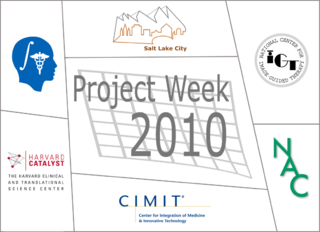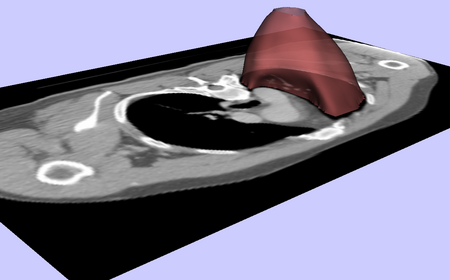Difference between revisions of "Adaptive Radiotherapy for Head, Neck, and Thorax"
From NAMIC Wiki
Ivan.kolesov (talk | contribs) |
Ivan.kolesov (talk | contribs) |
||
| Line 30: | Line 30: | ||
<h3>Approach, Plan</h3> | <h3>Approach, Plan</h3> | ||
| − | * | + | *Include a shape prior model. |
| − | + | *Include segmented structures as prior information in the form of landmarks. | |
| − | * | + | *Demonstrate an accurate segmentation on a handful of structures. |
| − | *Create an outline for further progress after the project week | + | *Create a strategy for coupling segmentation and registration tasks. |
| + | *Organize/pre-process as many cases as possible. | ||
| + | *Create an outline for further progress after the project week. | ||
| Line 41: | Line 43: | ||
<h3>Progress</h3> | <h3>Progress</h3> | ||
| − | * | + | *Initial segmentation results are shown above. |
| − | * | + | *A pipeline for including shape information exists; some synthetic experiments show its validity. |
| − | * | + | *Part of the data pre-processing pipeline is complete. |
Revision as of 01:18, 6 December 2009
Home < Adaptive Radiotherapy for Head, Neck, and Thorax
 Return to Projects List |
Key Investigators
- GaTech: Ivan Kolesov, Vandana Mohan, and Allen Tannenbaum
- MGH: Gregory Sharp
Objective
First, we are developing an algorithm to perform segmentation of a number of structures in the Head, Neck, and Thorax. In an effort to avoid offsetting the main advantage, accuracy, of using proton therapy, therapy plans that are based on imagery collected prior to the first session must be corrected over the course of the treatment. Once segmentation is available, the goal is to register patient scans to account for anatomical changes between visits.
Approach, Plan
- Include a shape prior model.
- Include segmented structures as prior information in the form of landmarks.
- Demonstrate an accurate segmentation on a handful of structures.
- Create a strategy for coupling segmentation and registration tasks.
- Organize/pre-process as many cases as possible.
- Create an outline for further progress after the project week.
Progress
- Initial segmentation results are shown above.
- A pipeline for including shape information exists; some synthetic experiments show its validity.
- Part of the data pre-processing pipeline is complete.
